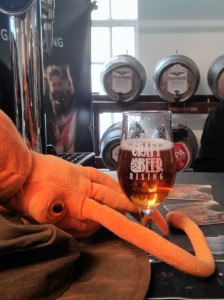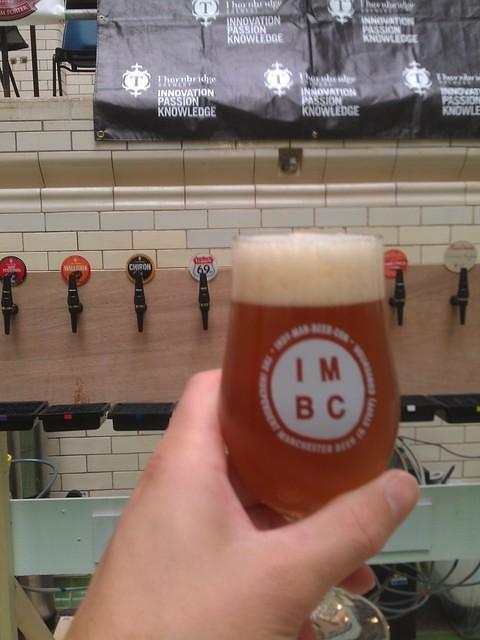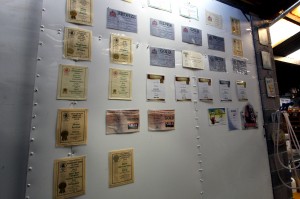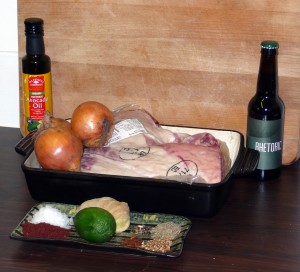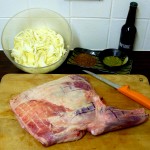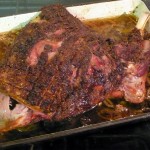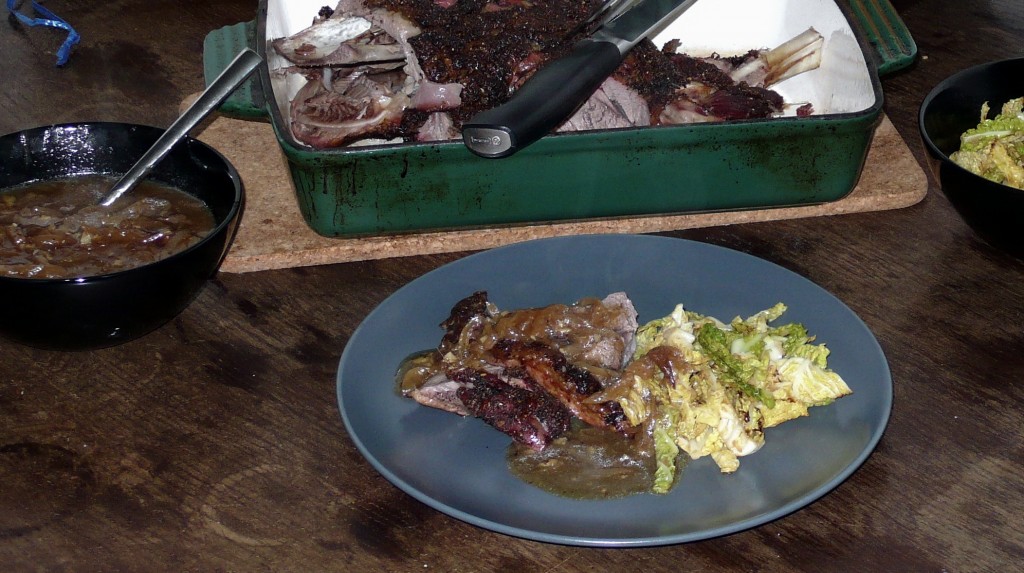 I’m recovering from Craft Beer Rising 2013 today — feeling utterly drained. Over-indulgence in beery delights does that. Of course it didn’t help that we downed some beautiful but strong beers in BrewDog Shoreditch after. Oh, and then had a bottle of Speedway Stout on the train. Ah, and had a pint of Green Devil in the Live & Let Live when we got back to Cambridge. Excessive drunken decadence. (Though in our defence not to the point of illness and memory loss!)
I’m recovering from Craft Beer Rising 2013 today — feeling utterly drained. Over-indulgence in beery delights does that. Of course it didn’t help that we downed some beautiful but strong beers in BrewDog Shoreditch after. Oh, and then had a bottle of Speedway Stout on the train. Ah, and had a pint of Green Devil in the Live & Let Live when we got back to Cambridge. Excessive drunken decadence. (Though in our defence not to the point of illness and memory loss!)
So how was this “Craft Beer Rising” gig? I’ve been asked this question a couple of times now and have been thinking about the answer. The simple answer is: it was a great beer event, worth the trip, and worth the money. Now read on if you’re interested in a much less simple answer…
Craft Beer Rising was a great event! Good beer, craft beer, interesting beer. It had a less craft vibe than the Independent Manchester Beer Convention and it felt a bit more like a trade-show. It had some decidedly not-at-all-craft-why-the-fuck-are-they-here attendees… but if that’s needed to pay the rent, say, and that means that events like this can work and be profitable then it is a small price to pay (and nobody forces you to drink their beer anyway.)
Importantly: Would I go again? Yes! However next time I might try and sneak myself into the trade session instead…
That’s the TL;DR — now for the properly “less simple” version…
I’m probably being incredibly unfair. I’m holding Craft Beer Rising up against the Independent Manchester Beer Convention for a compare-and-contrast despite the fact that my experience of the two events was very different. I volunteered for 3 shifts at IMBC, starting with set-up, and attended the entire event from start to finish over 2 days — it was a rich experience. For CBR on the other hand I attended just a single session on Saturday afternoon — more of an in & out surgical strike!
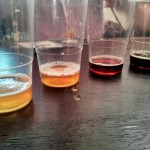 So how do these two non-CAMRA beer events compare? Craft Beer Rising felt more like a trade-show than a beer-festival. Each brewery involved had their own little booth — all branded up, staffed by brewery employees, and fronted by a solid high bar. In this sense it felt much closer in spirit to the brewery booths at GBBF than the more casual & slightly Heath-Robinson IMBC setup. To add to this feel we had many usual-faces of GBBF around the place as well — Marston’s, Greene King, Thwaites, and Brains for example. Even with the same staff in the latter two cases. (They recognised me from GBBF despite the lack of a mohawk!) The only real difference was the occasional keg font — in that sense this was quite clearly unlike a CAMRA event!
So how do these two non-CAMRA beer events compare? Craft Beer Rising felt more like a trade-show than a beer-festival. Each brewery involved had their own little booth — all branded up, staffed by brewery employees, and fronted by a solid high bar. In this sense it felt much closer in spirit to the brewery booths at GBBF than the more casual & slightly Heath-Robinson IMBC setup. To add to this feel we had many usual-faces of GBBF around the place as well — Marston’s, Greene King, Thwaites, and Brains for example. Even with the same staff in the latter two cases. (They recognised me from GBBF despite the lack of a mohawk!) The only real difference was the occasional keg font — in that sense this was quite clearly unlike a CAMRA event!
The presence of these breweries is probably one thing that made Craft Beer Rising feel less crafty than IMBC… This is unfair perhaps, Brains and Thwaites are making an effort to produce interesting beers that work for us non-traditionalists. Sharp’s too — sure, the brewery is owned by Molson Coors, but you’d be a jerk to call the amazing, weird, and wonderful stuff Stuart Howe does “not craft” just because of that. Marston’s and Greene King on the other hand were notably & unsurprisingly dull. I did try a couple of their ales, the Marston’s single-hop beer and the Greene King Yard Bird, both decent golden bitters and nothing wrong with them. Though to market Yard Bird as inspired by American IPAs is kind of taking the piss if you ask me. It really was a bit “why are they here?” I’m not saying the event wasn’t “craft” because these breweries were present — I’m just saying that my feel for the vibe of the event was less craft than IMBC (which felt like basking in pure distillate of craft). “Craft” is such a difficult & argument-inducing term!
 In my opinion CBR was also notable for who wasn’t present. None of my “top picks” for British craft beer were there. Again this is a purely personal thing… but no Buxton, Summer Wine, Magic Rock, Hardknott, Kernel, or Moor (just to rattle off a few that come to mind). Of course not every brewery can be represented… but for none of these to be there? Hmmm… There were of course Thornbridge, BrewDog, and the aforementioned Sharp’s. Established “craft” players with decent marketing budgets — I suspect that part of the problem might have been the cost of the event filtering out the small guys. (The Rake Bar did a bit to fill the gap. They had beers on from Summer Wine, Windsor & Eton, and Redemption for example. So some of the beer was there but the breweries weren’t.)
In my opinion CBR was also notable for who wasn’t present. None of my “top picks” for British craft beer were there. Again this is a purely personal thing… but no Buxton, Summer Wine, Magic Rock, Hardknott, Kernel, or Moor (just to rattle off a few that come to mind). Of course not every brewery can be represented… but for none of these to be there? Hmmm… There were of course Thornbridge, BrewDog, and the aforementioned Sharp’s. Established “craft” players with decent marketing budgets — I suspect that part of the problem might have been the cost of the event filtering out the small guys. (The Rake Bar did a bit to fill the gap. They had beers on from Summer Wine, Windsor & Eton, and Redemption for example. So some of the beer was there but the breweries weren’t.)
The feeling I got from discussions on twitter is that this odd selection of breweries turned a lot of craft-beer-loving drinkers away from the event. No harm done, because the event sold out anyway! However few people I know bothered — even those in London — and thus it was a somewhat less lively and animated affair for us. (Some did go to the “trade session” on Friday, and there I re-note that the fact I went to ALL of IMBC and just one session of CBR does make the comparison unfair.) On the up-side this meant I actually had time to “check in” most of the beers I tried on Untappd. We did meet up with Nathaniel Southwood at least, and hung out with him after the event for some beers in BrewDog Shoreditch — but 3 beer geeks does not a full party make! The sad part of this is that those who chose to reject the event because of the brewery list did miss out in my opinion. Nobody was forced to drink Greene King IPA and the good beer wasn’t any less good just because there was a cask of it in the room. There was some incredibly good beer on offer. I had made a “shortlist” of 16 different beers I wanted to try, more than enough for four and a half hours of drinking. (I didn’t manage to try them all.)
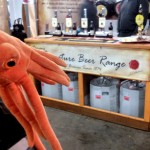 Another contributor to the different vibe was that people were trying to *sell* me their beer. No, not by the glass… they were doing that of course. I mean 50% of the time when I was chatting to someone at a stand about beer the conversation rolled around to how I can order their beer for a beer festival/pub/etc. Business cards… sales people. This contributed to the “trade show” feeling I suppose. I’ve nothing against people wanting to sell me their beer! In fact I’m quite happy to have met a chap from Osset/Rat brewery on this front & may be in touch with them if I do another CAMRA festival order in the future. Basically IMBC seemed to have more brewers and less sales people. That said, several of the breweries at IMBC were ones I’d previously dealt with thus they knew I already buy their beer (and that I already like buying their beer!)
Another contributor to the different vibe was that people were trying to *sell* me their beer. No, not by the glass… they were doing that of course. I mean 50% of the time when I was chatting to someone at a stand about beer the conversation rolled around to how I can order their beer for a beer festival/pub/etc. Business cards… sales people. This contributed to the “trade show” feeling I suppose. I’ve nothing against people wanting to sell me their beer! In fact I’m quite happy to have met a chap from Osset/Rat brewery on this front & may be in touch with them if I do another CAMRA festival order in the future. Basically IMBC seemed to have more brewers and less sales people. That said, several of the breweries at IMBC were ones I’d previously dealt with thus they knew I already buy their beer (and that I already like buying their beer!)
The imported beer selection was odd at best. I think we have US companies trying to “buy in” to the UK “craft beer” market? Stone, Ballast Point, Rogue, yes… some of these make beers that are certainly worth importing. Fordham? Point? No… why bother? What’s the point? And what the fuck was up with the clear-bottled rum-flavoured Innis-and-Gun style stuff? I just felt I was being too heavily marketed at when I looked at some of these set-ups. I’d expect slick brands like BrewDog and Thornbridge to feel like this, but they were pleasant and real by comparison — with stands staffed by people who’re really into beer and not just spouting sales-pitch at you.
I didn’t spend a lot of time people-watching but the general feel and vibe of the crowd was young, so unlike typical CAMRA affairs. I’m used to being young for beer festivals, but at CBR I felt a bit old! I think the CBR crowd may have been even younger on average than that of IMBC. This really changes the atmosphere of the event — it’s more lively, and as a result more enjoyable. People who know me probably won’t believe that… I hate crowds. But if I have to be in a crowd I’d rather it be a happy-feeling one. This may be a little unfair on CAMRA festivals but they do tend to feel, to me, quite grumpy sometimes.
 I didn’t catch much by way of the talk/event programme. It seemed a little less organised than the IMBC talks/tastings. That said I’m not going to complain about being given free beer and nibbles by Melissa Cole at the one talk I did attend. Beer and food matching of course!
I didn’t catch much by way of the talk/event programme. It seemed a little less organised than the IMBC talks/tastings. That said I’m not going to complain about being given free beer and nibbles by Melissa Cole at the one talk I did attend. Beer and food matching of course!
Just like IMBC the food at CBR was excellent… and so unlike most CAMRA festivals! I think CBR did a little better on the food front actually — merely because I didn’t have to queue for 10 minutes to get my lunch! :) However IMBC did have better sausage.
An eternal problem of beer festivals: toilets. The facilities were overwhelmed! Will there ever be a beer festival that has adequate toliet facilities? The worst part about the men’s toilets in this place was the high flat metal urinal. There you are taking a leak and some drunk chap steps in next to you and… well, it’s a bit splashy. Ick.
On that note I’ll wrap up this loose collection of only vaguely organised thoughts. The weekend is over, I’ve not done much at all today and I still feel pretty damn shattered. Craft Beer Rising 2013 was good fun, despite my criticisms, and I’d have liked to have done an extra session… I missed out on a few beers I’m just now hearing good things about. Oh well, maybe next time!
